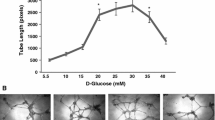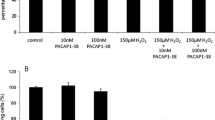Abstract
Our aim was to investigate the effect of high levels of glucose, insulin, leptin, and tumor necrosis factor alpha, biomarkers of diabetes in pregnancy, in the process of placentation, using as a cell model a first trimester extravillous human trophoblast cell line (HTR8/SVneo cells). Exposure of HTR8/SVneo cells for 24 hours to either glucose (20 mmol/L) or leptin (25–100 ng/mL) did not cause significant changes in cell proliferation and viability. Tumor necrosis factor alpha (24 hours; 10–100 ng/L) caused a small decrease (10%) in cell proliferation and an increase (9%) in cell viability; however, both effects disappeared when exposure time was increased. Insulin (24 hours; 1–10 nmol/L) caused a concentration- and time-dependent decrease (10%–20%) in cell proliferation; the effect of insulin (10 nmol/L) was more pronounced after a 48 hours exposure (35%). In contrast, exposure to insulin (10 nmol/L; 48 hours) showed no significant effect on cell viability, apoptosis, and migration capacity. Insulin appears to cause hypertrophy of HTR8/SVneo cells as it reduces the cell mitotic index while increasing the culture protein content. The anti-proliferative effect of insulin seems to involve activation of mammalian target of rapamycin, phosphoinositide 3-kinase, and p38 mitogen-activated protein kinase. Finally, simvastatin and the polyphenol quercetin potentiated the antiproliferative effect of insulin; on the contrary, the polyphenol resveratrol, the polyunsaturated fatty acids eicosapentaenoic and docosahexaenoic acids, and folic acid were not able to change it. In conclusion, we show that insulin has an antiproliferative and hypertrophic effect on a first trimester extravillous human trophoblast cell line. So insulin might affect the process of placentation.
Similar content being viewed by others
References
Regnault TR, Galan HL, Parker TA, Anthony RV. Placental development in normal and compromised pregnancies—a review. Placenta. 2002;23(suppl A):S119–S129.
Fowden AL, Forhead AJ, Coan PM, Burton GJ. The placenta and intrauterine programming. J Neuroendocrinol. 2008;20(4):439–450.
Forbes K, Westwood M. Maternal growth factor regulation of human placental development and fetal growth. J Endocrinol. 2010;207(1):1–16.
Ji L, Brkic J, Liu M, Fu G, Peng C, Wang YL. Placental trophoblast cell differentiation: physiological regulation and pathological relevance to preeclampsia. Mol Aspects Med. 2013;34(5):981–1023.
James JL, Carter AM, Chamley LW. Human placentation from nidation to 5 weeks of gestation. Part I: what do we know about formative placental development following implantation? Placenta. 2012;33(5):327–334.
Sacks DA, Hadden DR, Maresh M, et al. HAPO Study Cooperative Research Group. Frequency of gestational diabetes mellitus at collaborating centers based on IADPSG consensus panel-recommended criteria: the Hyperglycemia and Adverse Pregnancy Outcome (HAPO) Study. Diabetes Care. 2012;35(3):526–528.
Magon N, Chauhan M. Pregnancy in type 1 diabetes mellitus: how special are special issues? N Am J Med Sci. 2012;4(6):250–256.
Lepercq J, Cauzac M, Lahlou N, et al. Overexpression of placental leptin in diabetic pregnancy: a critical role for insulin. Diabetes. 1998;47(5):847–850.
Desoye G, Hauguel-de Mouzon S. The human placenta in gestational diabetes mellitus. the insulin and cytokine network. Diabetes Care. 2007;30(suppl 2):S120–S126.
Vambergue A, Fajardy I. Consequences of gestational and pregestational diabetes on placental function and birth weight. World J Diabetes. 2011;2(11):196–203.
Graham CH, Hawley TS, Hawley RG, et al. Establishment and characterization of first trimester human trophoblast cells with extended lifespan. Exp Cell Res. 1993;206(2):204–211.
Hill JR, Kwon G, Marshall CA, McDaniel ML. Hyperglycemic levels of glucose inhibit interleukin 1 release from RAW 264.7 murine macrophages by activation of protein kinase C. J Biol Chem. 1998;273(6):3308–3313.
Mandl M, Haas J, Bischof P, Nohammer G, Desoye G. Serum-dependent effects of IGF-I and insulin on proliferation and invasion of human first trimester trophoblast cell models. Histochem Cell Biol. 2002;117(5):391–399.
Magarinos MP, Sanchez-Margalet V, Kotler M, Calvo JC, Varone CL. Leptin promotes cell proliferation and survival of trophoblastic cells. Biol Reprod. 2007;76(2):203–210.
Gonzalez E, Flier E, Molle D, Accili D, McGraw TE. Hyperinsulinemia leads to uncoupled insulin regulation of the GLUT4 glucose transporter and the FoxO1 transcription factor. Proc Natl Acad Sci USA. 2011;108(25):10162–10167.
Stubert J, Waldmann K, Dieterich M, Richter DU, Briese V. Progranulin shows cytoprotective effects on trophoblast cells in vitro but does not antagonize TNF-alpha-induced apoptosis. Arch Gynecol Obstet. 2014;290(5):867–873.
Araujo JR, Correia-Branco A, Ramalho C, et al. L-Methionine placental uptake: characterization and modulation in gestational diabetes mellitus. Reprod Sci. 2013;20(12):1492–1507.
Araujo JR, Correia-Branco A, Ramalho C, Keating E, Martel F. Gestational diabetes mellitus decreases placental uptake of long-chain polyunsaturated fatty acids: involvement of long-chain acyl-CoA synthetase. J Nutr Biochem. 2013;24(10):1741–1750.
Araujo JR, Correia-Branco A, Moreira L, Ramalho C, Martel F, Keating E. Folic acid uptake by the human syncytiotrophoblast is affected by gestational diabetes, hyperleptinemia, and TNF-alpha. Pediatr Res. 2013;73(4 pt 1):388–394.
Mosmann T. Rapid colorimetric assay for cellular growth and survival: application to proliferation and cytotoxicity assays. J Immunol Methods. 1983;65(1-2):55–63.
Bergmeyer HU, Bernt E. Lactate dehydrogenase. In: Bergmeyer HU, ed. Methods of Enzymatic Analysis. Vol. 2. New York, NY: Verlag Chemie; 1974:574–579
Bradford MM. A rapid and sensitive method for the quantitation of microgram quantities of protein utilizing the principle of protein-dye binding. Anal Biochem. 1976;72(1):248–254.
Ben-Haroush A, Yogev Y, Hod M. Epidemiology of gestational diabetes mellitus and its association with type 2 diabetes. Diabet Med. 2004;21(2):103–113.
Barbour LA, McCurdy CE, Hernandez TL, Kirwan JP, Catalano PM, Friedman JE. Cellular mechanisms for insulin resistance in normal pregnancy and gestational diabetes. Diabetes Care. 2007;30(2):112–119.
Pollock KE, Stevens D, Pennington KA, et al. Hyperleptinemia during pregnancy decreases adult weight of offspring and is associated with increased offspring locomotor activity in mice. Endocrinology. 2015;156(10):3777–3790.
Mayama R, Izawa T, Sakai K, Suciu N, Iwashita M. Improvement of insulin sensitivity promotes extravillous trophoblast cell migration stimulated by insulin-like growth factor-I. Endocr J. 2013;60(3):359–368.
Westgate JA, Lindsay RS, Beattie J, et al. Hyperinsulinemia in cord blood in mothers with type 2 diabetes and gestational diabetes mellitus in New Zealand. Diabetes Care. 2006;29(6):1345–1350.
Lassance L, Miedl H, Absenger M, et al. Hyperinsulinemia stimulates angiogenesis of human fetoplacental endothelial cells: a possible role of insulin in placental hypervascularization in diabetes mellitus. J Clin Endocrinol Metab. 2013;98(9):E1438–E1447.
Perez-Perez A, Guadix P, Maymo J, et al. Insulin and leptin signaling in placenta from gestational diabetic subjects. Horm Metab Res. 2016;48(1):62–69.
Hiden U, Glitzner E, Hartmann M, Desoye G. Insulin and the IGF system in the human placenta of normal and diabetic pregnancies. J Anat. 2009;215(1):60–68.
Hiden U, Maier A, Bilban M, et al. Insulin control of placental gene expression shifts from mother to foetus over the course of pregnancy. Diabetologia. 2006;49(1):123–131.
Knofler M. Critical growth factors and signalling pathways controlling human trophoblast invasion. Int J Dev Biol. 2010;54(2-3): 269–280.
Blagosklonny MV. TOR-centric view on insulin resistance and diabetic complications: perspective for endocrinologists and gerontologists. Cell Death Dis. 2013;4(12):964–972.
Murakami M, Ichisaka T, Maeda M, et al. mTOR is essential for growth and proliferation in early mouse embryos and embryonic stem cells. Mol Cell Biol. 2004;24(15):6710–6718.
Ferretti C, Bruni L, Dangles-Marie V, Pecking AP, Bellet D. Molecular circuits shared by placental and cancer cells, and their implications in the proliferative, invasive an migratory capacities of trophoblasts. Hum Reprod Update. 2007;13(2):121–141.
Ambrosino C, Nebreda AR. Cell cycle regulation by p38 MAP kinases. Bio cell. 2001;93(1-2):47–51.
Singh CK, Kumar A, Lavoie HA, Dipette DJ, Singh US. Diabetic complications in pregnancy: is resveratrol a solution? Exp Biol Med (Maywood). 2013;238(5):482–490.
Zou Y, Zuo Q, Huang S, et al. Resveratrol inhibits trophoblast apoptosis through oxidative stress in preeclampsia-model rats. Molecules. 2014;19(12):20570–20579.
Chen B, Tuuli MG, Longtine MS, et al. Pomegranate juice and punicalagin attenuate oxidative stress and apoptosis in human placenta and in human placental trophoblasts. Am J Physiol Endocrinol Metab. 2012;302(9):E1142–E1152.
Klingler M, Blaschitz A, Campoy C, et al. The effect of docosa-hexaenoic acid and folic acid supplementation on placental apop-tosis and proliferation. Br J Nutr. 2006;96(1):182–190.
Wietrak E, Kaminski K, Leszczynska-Gorzelak B, Oleszczuk J. Effect of docosahexaenoic acid on apoptosis and proliferation in the placenta: preliminary report. Biomed Res Int. 2015;2015: 482875.
Jones ML, Mark PJ, Waddell BJ. Maternal dietary omega-3 fatty acids and placental function. Reproduction. 2014;147(5):143–152.
Basak S, Das MK, Duttaroy AK. Fatty acid-induced angiogenesis in first trimester placental trophoblast cells: possible roles of cellular fatty acid-binding proteins. Life Sci. 2013;93(21):755–762.
Antony AC. In utero physiology: role of folic acid in nutrient delivery and fetal development. Am J Clin Nutr. 2007;85(2):598–603.
Ahmed T, Fellus I, Gaudet J, MacFarlane AJ, Fontaine-Bisson B, Bainbridge SA. Effect of folic acid on human trophoblast health and function in vitro. Placenta. 2016;37:7–15.
Forbes K, Shah VK, Siddals K, Gibson JM, Aplin JD, Westwood M. Statins inhibit insulin-like growth factor action in first trimester placenta by altering insulin-like growth factor 1 receptor glycosylation. Mol Hum Reprod. 2015;21(1):105–114.
Kenis I, Tartakover-Matalon S, Cherepnin N, et al. Simvastatin has deleterious effects on human first trimester placental explants. Hum Reprod. 2005;20(10):2866–2872.
Godfrey LM, Erramouspe J, Cleveland KW. Teratogenic risk of statins in pregnancy. Ann Pharmacother. 2012;46(10):1419–1424.
Zarek J, Koren G. The fetal safety of statins: a systematic review and meta-analysis. J Obstet Gynaecol Can. 2014;36(6):506–509.
Andrade SE, Raebel MA, Brown J, et al. Outpatient use of cardiovascular drugs during pregnancy. Pharmacoepidemiol Drug Saf. 2008;17(3):240–247.
Egert S, Wolffram S, Bosy-Westphal A, et al. Daily quercetin supplementation dose-dependently increases plasma quercetin concentrations in healthy humans. J Nutr. 2008;138(9):1615–1621.
Brull V, Burak C, Stoffel-Wagner B, et al. Effects of a quercetinrich onion skin extract on 24 h ambulatory blood pressure and endothelial function in overweight-to-obese patients with (pre-)-hypertension: a randomised double-blinded placebo-controlled cross-over trial. Br J Nutr. 2015;114(8):1263–1277.
Araujo JR, Goncalves P, Martel F. Chemopreventive effect of dietary polyphenols in colorectal cancer cell lines. Nutr Res. 2011;31(2):77–87.
Nomura M, Takahashi T, Nagata N, et al. Inhibitory mechanisms of flavonoids on insulin-stimulated glucose uptake in MC3T3-G2/ PA6 adipose cells. Biol Pharm Bull. 2008;31(7):1403–1409.
Johnsen GM, Basak S, Weedon-Fekjær MS, et al. Docosahexaenoic acid stimulates tube formation in first trimester trophoblast cells, HTR8/SVneo. Placenta. 2011;32(9):626–632.
Bjorkhem-Bergman L, Lindh JD, Bergman P. What is a relevant statin concentration in cell experiments claiming pleiotropic effects? Br J Clin Pharmacol. 2011;72(1):164–165.
Bellosta S, Ferri N, Bernini F, Paoletti R, Corsini A. Non-lipid-related effects of statins. Ann Med. 2000;32(3):164–176.
Nordstrand A, Lundholm M, Larsson A, Lerner UH, Widmark A, Wikstrom P. Inhibition of the insulin-like growth factor-1 receptor enhances effects of simvastatin on prostate cancer cells in co-culture with bone. Cancer Microenviron. 2013;6(3):231–240.
Knofler M, Mosl B, Bauer S, Griesinger G, Husslein P. TNF-alpha/TNFRI in primary and immortalized first trimester cytotro-phoblasts. Placenta. 2000;21(5-6):525–535.
Basak S, Das MK, Srinivas V, Duttaroy AK. The interplay between glucose and fatty acids on tube formation and fatty acid uptake in the first trimester trophoblast cells, HTR8/SVneo. Mol Cell Biochem. 2015;401(1-2):11–19.
Weiss U, Cervar M, Puerstner P, et al. Hyperglycaemia in vitro alters the proliferation and mitochondrial activity of the choriocarcinoma cell lines BeWo, JAR an JEG-3 as models for human first-trimester trophoblast. Diabetologia. 2001;44(2):209–219.
Masumoto A, Takamoto N, Masuyama H, Akahori Y, Inoue S, Hiramatsu Y. Effects of intermittent high glucose on BeWo choriocarcinoma cells in culture. J Obstet Gynaecol Res. 2011;37(10):1365–1375.
Chen H, Wu Y, Liu B, Li Z, Wang Z. Adiponectin exerts anti-proliferative effect on human placenta via modulation of the JNK/ c-Jun pathway. Int J Clin Exp Pathol. 2014;7(6):2894–2904.
Belkacemi L, Lash GE, Macdonald-Goodfellow SK, Caldwell JD, Graham CH. Inhibition of human trophoblast invasiveness by high glucose concentrations. J Clin Endocrinol Metab. 2005;90(8):4846–4851.
Cauzac M, Czuba D, Girard J, Hauguel-de Mouzon S. Transduction of leptin growth signals in placental cells is independent of JAK-STAT activation. Placenta. 2003;24(4):378–384.
Seki H, Matuoka K, Inooku H, Takeda S. TNF-alpha from monocyte of patients with pre-eclampsia-induced apoptosis in human trophoblast cell line. J Obstet Gynaecol Res. 2007;33(4):408–416.
Author information
Authors and Affiliations
Corresponding author
Rights and permissions
About this article
Cite this article
Silva, C., Nunes, C., Correia-Branco, A. et al. Insulin Exhibits an Antiproliferative and Hypertrophic Effect in First Trimester Human Extravillous Trophoblasts. Reprod. Sci. 24, 582–594 (2017). https://doi.org/10.1177/1933719116667220
Published:
Issue Date:
DOI: https://doi.org/10.1177/1933719116667220




